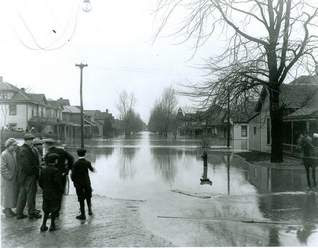Spent last night after work picking up the mess and man are my legs sore from all the bending!! If wind stays calm today, we plan on burning the pile of debris after work today. The pile is almost as tall as me. I know, that's not saying much LOL but needs to go before the next round of mowing.
Today in History:
June 11, 1776
Congress appoints “Committee of Five” to draft the Declaration of Independence
On this day in 1776, the Continental Congress selects Thomas Jefferson of Virginia, John Adams of Massachusetts, Benjamin Franklin of Pennsylvania, Roger Sherman of Connecticut and Robert R. Livingston of New York to draft a declaration of independence.June 11, 1962
Alcatraz proves escapable for three men
John and Clarence Anglin and Frank Lee Morris attempt to escape from Alcatraz federal prison. The three men were never seen again, and although some believe that theirs was the only successful getaway from what was known as "The Rock," it is far more likely that they drowned in the chilly water. Four days after their escape, a bag containing photos, which belonged to Clarence Anglin, was found in San Francisco Bay. Escape From Alcatraz, both a J. Campbell Bruce book and a Clint Eastwood movie, later dramatized the incident.
June 11, 1979John Wayne dies
On this day in 1979, John Wayne dies. The star of countless westerns, Wayne had been battling cancer for more than a decade.
Wayne was born Marion Michael Morrison in 1908 in Iowa. He moved as a child to Glendale, California. A football star at Glendale High School, he attended the University of Southern California on a scholarship but dropped out after two years. Working as a movie studio laborer, he befriended rising director John Ford. Wayne played bit parts under the name of Duke Morrison (a childhood nickname derived from the family dog, Marion's constant companion). In 1930, a college buddy, Raoul Walsh, hired him for $75 a week for his first starring role, in Walsh's film The Big Trail, which flopped.Indiana History:
The Great Flood of 1913 recalled
Water levels have surpassed those of 1913 catastrophe in some areas
 (from The Star Press) The Great Flood of 1913, as it's told, was the most devastating flood to ever hit Muncie and the surrounding areas.
(from The Star Press) The Great Flood of 1913, as it's told, was the most devastating flood to ever hit Muncie and the surrounding areas.
The swollen White River was responsible for the death of a Yorktown man and caused damage estimated at $500,000 (equivalent to $10,890,000 in 2008, according to the Federal Reserve Bank of Minneapolis).
Dorothea Hensley of Muncie was born three years too late to witness the flood, but certainly heard all about the devastation when she was a little girl.
"My dad and mother told me the story," Hensley said. "I heard it many times."
The story begins with the wedding of Hensley's parents, Elisha and Irene Losh, who exchanged vows that year in their hometown of Matthews, located about 16 miles northwest of Muncie.
After the wedding, the newlyweds had planned to travel to a farmhouse near the Gaston-Yorktown Pike where Elisha accepted a job.
Those plans, however, were put on hold when flood waters wreaked havoc on the area.
"They couldn't (leave)," Hensley said. "The bridge wasn't there."
The bridge, as Hensley remembers the story, was washed away by the strong water currents, leaving the couple stranded in Matthews.
Hensley said workers eventually pulled the wood bridge back to its location with teams of horses.
Nowadays, the method of recovery is much different than chain-pulling horses. But the effects of the flood are just as devastating.
Indiana is witnessing record-breaking water levels that have surpassed those of 1913 in some areas.
And while records had already been broken by Monday, more rain continued to fall Tuesday and the death toll rose to at least three people across Indiana.
"We've had a lot of rain, that's for sure," said 77-year-old Thomas Crooks, who lives in the McKinley neighborhood just northeast of downtown Muncie.
Crooks' family history in that neighborhood dates back to the early 1900s, when his grandfather lived at 625 N. Elm St. during the flood of 1913.
Crooks, of course, wasn't alive at the time -- but like Hensley, he remembers the stories.
"Every time we had a big rain they would talk about the flood back then," Crooks said.
The family house still stands and ironically Crooks lives directly next door.
He doesn't know how much damage the home received during the flood. But he's sure the basement had standing water.
"The basement always floods," he said. "It still does."
It's easy for Crooks to somewhat imagine how it might have been in 1913 from photographs and postcards passed down by family members.
In fact, he has a black-and-white picture dated March 25, 1913, that shows a flooded Elm Street with the Crooks family home visible in the photo.
Crooks said his great-grandfather kept a tidy journal about life in Muncie, up until his death in 1910.
Oddly, the journal also included meticulous weather conditions, according to Crooks.
"He must have gone out every hour to figure out which direction the wind was blowing," said Crooks of his great-grandfather.
Crooks is certain his great-grandfather would've written about the Great Flood of 1913 had he lived long enough to see it.
"He would've," Crooks said. "But he died too early."
2nd photo is a group of boys looking at flooded Elm Street from Wysor Street.
There is water control now because of this flood but you can never control Mother Nature completely, as we've learned. Be safe everyone!

No comments:
Post a Comment